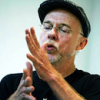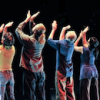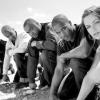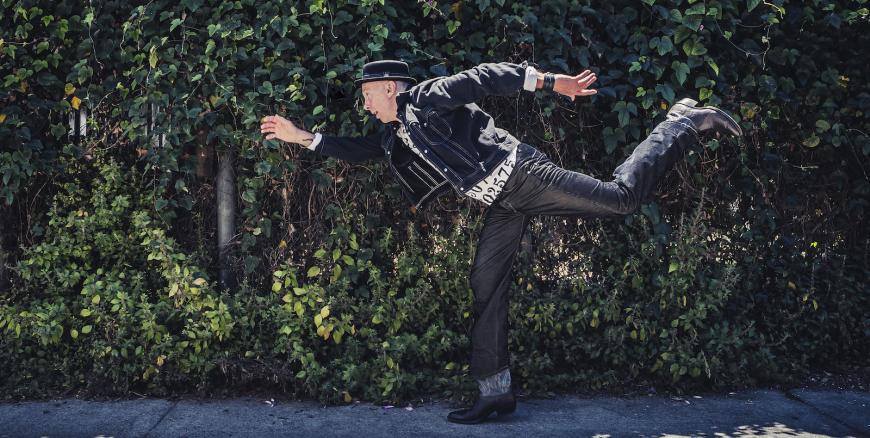
At some point during the live-performance-deprived months of the pandemic lockdown, I recall roaming in pursuit of body music online and through my collection. I stumbled on a recording or a video of Inuit throat singing. The traditional vocal form largely practiced and performed by Inuit women on the North American continent has two singers standing face-to-face in tight proximity: They move rhythmically and pass back and forth short vocal phrases projected almost directly into each other’s mouths for enhanced resonance. At a song’s conclusion, they often engage in deep belly laughter. I remember thinking, “Well, that’s not going to be happening.” Not only did COVID-19 prior to vaccines make singing together in one large room potentially lethal, the rich sound of laughter was rare, improbable, and on many days seemed impossible.
That is why my conversation with drummer, bassist, and body-music artist Keith Terry in early October as live performances resume begins with a conversation about lost art forms. I ask, “What traditional body music is at greatest risk of being lost? What movements are happening to ensure they’re not lost?”
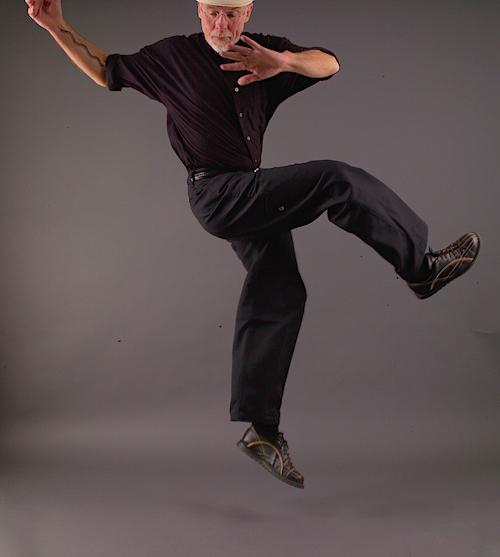
In reply, Terry offers a brief history lesson and says, “In North America, as the result of the slave trade, there was the taking away of drums from enslaved people. They started playing the rhythms on their bodies. Hambone. Most scholars agree this started as the result of the Stono Rebellion that happened in 1739 along the Stono River in [South] Carolina. [The date marks the largest slave rebellion in the Southern Colonies, with 25 colonists and 35 to 50 Africans killed.] Hambone is still going strong. Not everyone knows about it; it’s not a Main Street thing, but there are still older people passing it down to younger people today. Body music endures.”
Body Music, the traditional styles, were not intended for performance. Terry says Indigenous styles were embedded in culture, with community purposes. “In Canada, there’s the Inuit throat singing and from what I can tell now, a lot of young people are interested. It’s not a revival; it never disappeared. I’ve been aware of it for 30 years and I hear more about it now than I did [when I first learned about it]. And because of YouTube, it’s more accessible. I can find it now.
“There are cases where there are dangers of things that can be lost, just like languages. I’m thinking of Javanese gamelan. It has the risk of being lost because it’s too gentle in a hostile, aggressive world. There’s not been a huge movement of young people playing gamelan, it’s mostly older people. If it keeps moving in that direction, will it be lost? I don’t know. There are people who crave gentle music but it’s not a mass movement. Body music also moves against the technological age we live in, with all our devices. It’s purely unplugged. It’s an antidote for constantly being on our phones, our computers. It’s a way to bring ourselves back to our bodies. It’s more popular in Europe and South America, as opposed to North America, although there are great pockets in Canada. Still, these artists are not household names.”
Terry’s boundless curiosity has him engaged in a vast number of activities. Among them, participating in the San Francisco International Arts Festival, performing Oct. 24 with Free Dive, the collaborative band formed in 2003 and featuring Jeff Cressman (trombone), Bryan Dyer (vocals), Cecilia Engelhart (vocals), Steve Hogan (bass/beatbox) and Terry (drums/body music). He is the executive artistic director of Crosspulse, a nonprofit dedicated to creating, performing, and recording intercultural music and dance that blazes body music trails with “music you can see, dance you can hear,” according to Terry. There are also the International Body Rhythm Festival and workshops, a math curriculum he has developed, and performing as a member of the Evie Ladin Band, a trio led by his wife and frequent collaborative partner, Evie Ladin. It’s a body music mini-empire, with roots firmly planted in long-term friendships and music from around the world.
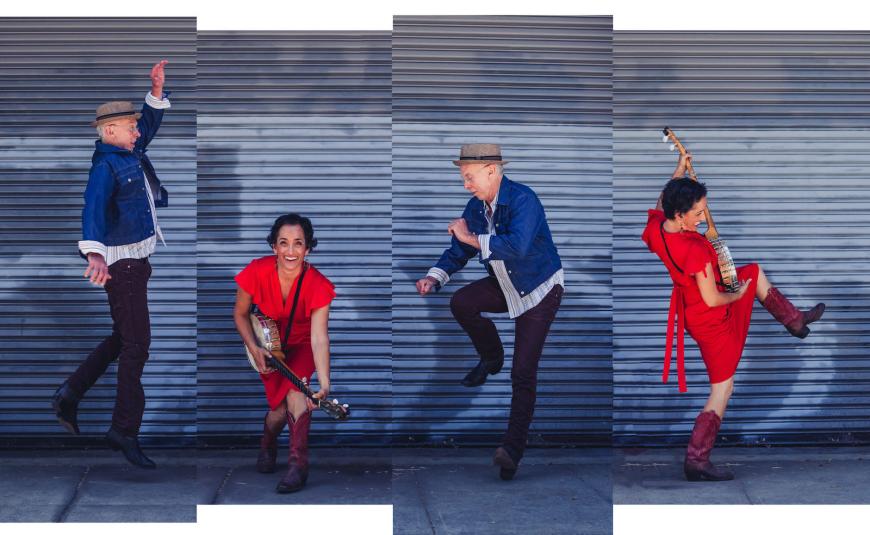
Here is more of our conversation:
Free Dive at the SFIFF: Instead of covering the whole gamut, will you select a few works or something on the program to highlight?
We’re releasing a new album in November, self-titled Free Dive. We’ll be playing the material from that, which is exciting. Through the course of recording an album, you learn the music deeply inside and out. You come out of that process with new information. I’ll take International Man of Mystery as an example, composed by Cecilia Engelhart. We came out with a nice grooving sound. We added a triangle to it, which we’d not been able to do because there’s very little overdubbing in the recording. It’s mostly live, but there are a few choice percussive sounds we decided to add. I have this Louisiana triangle that plays Cajun music and it plays beautifully. It really drives the beginning of the song.
The triangle blended so well. It just burns through the track — that metal sound. We hadn’t played the song with that live because of the logistical issues (of my playing drums at same time) so it adds energy. We also added roosters’ sounds in one place after a section that’s bombastic, almost like street drumming in Brazil. We’ve traveled to Brazil and Indonesia, places where there are lots of roosters. So it just seemed kind of natural. We found sample recordings of roosters and used three different crows. It speaks to the feeling of places like Brazil and the sounds are part of the sonic palette of those environments.
And then then there’s only one solo and it’s on the first track of the album and it’s a bass solo. It’s unusual, but we felt it represents the group, it’s an upbeat song. The song travels to many places, it borders on classical new music, jazz, world music, there’s a Moroccan feel, a samba in there.
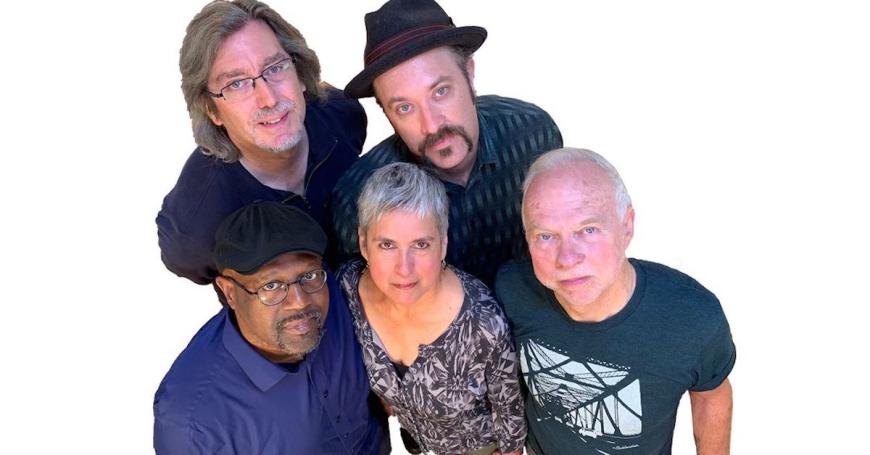
Your nonprofit Crosspulse is rooted in making and recording music but extends to grander agendas. How do the collaborations involved feed into that? In what ways, for example, has working with Gamelan Sekar Jaya, Turtle Island String Quartet, and Linda Tillery stretched or multiplied the possibilities?
My wife says I’m a victim of an overactive imagination. It’s a blessing and a curse. In my teens I listened to those early Nonesuch records of world music. That desire, that curiosity never left; I just got more deeply involved. I moved from listening to those records to actually studying with teachers from those places and going to those places. I ended up collaborating with people over time. A lot of those collaborations are very long-term relationships that I had with my teachers and musicians I met. It’s logical to me: It’s an extension of the curiosity. I’ve been lucky to work as a drummer, and that’s taken me all over the world, meeting amazing artists over the years. That makes for the disparate list. The core interest has been there for a long time and slowly developing. Crosspulse has been a nice vehicle for that. I started it in 1978 and it’s been going strong ever since.
The scary part [of collaborating] is that sometimes these are large scale, projects. They involve a lot of funding, there’s a lot at stake. With the international festivals, they can fall apart at any moment because there are so many moving parts beyond my control. I’ve been really lucky that I’ve taken a lot of risks in my career and for the most part they have worked out well.
Collaborations are a deep part of my core. Artistic and social collaborations are closely related. Look at the International Body Music Festival. We’ve been able to produce it in many parts of the world, not just here where I started it. We did it in Ghana, Bali, Brazil, and Greece and so many places. We’ve done that as the result of meeting artists, usually on tour. We hit it off, jammed some, performed to together at a festival, and then it triggers a friendship. As that friendship grows, we decide to produce together and they become co-producers in their country.
It’s sparked by the artistic, and then becomes a friendship, and each [collaboration] comes with its own satisfaction, warm, fuzzy feelings, and the anxiety of the unknown. I love collaboration rather than being a dictatorial director. The work is more interesting: I always learn something. There’s a spark to that that’s exciting.
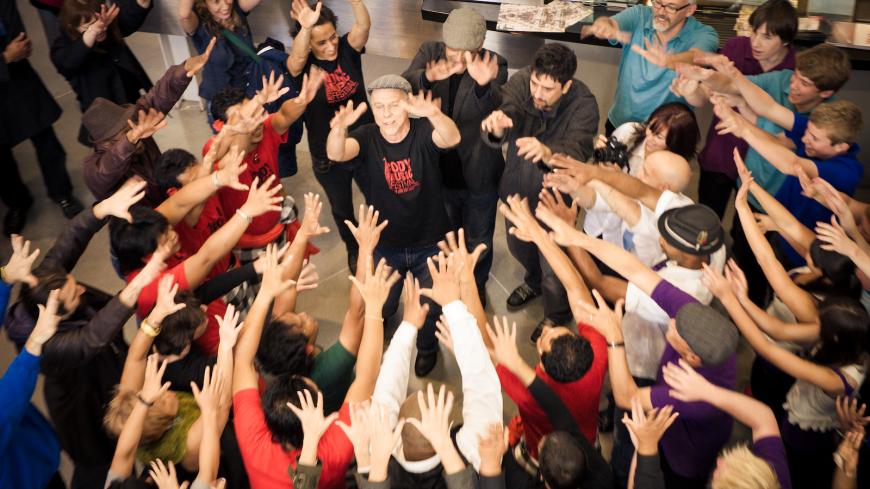
The International Body Music Festival and Workshops: Are there primary and unique ways in which people hear and experience sound and rhythms generated by and from the physical body? Maybe set aside lyrics?
I don’t separate words and voice, but for purposes of the question, it can be heard in different ways. This speaks to its power: It is such a tactile art form. You feel it with your body as well as hear it with your ears. You’re playing it with your chest, hands, legs. You’re stepping, clapping, cupping your hands. It’s a physical experience. So right there, there are two ways you’re listening.
If you’re looking in a mirror, or playing with someone else, you have a visual connection too. You have patterning with the hand and body: it’s a visual rhythm you can see. All these things are so special to the art from. They have great powers too.
Oliver Sacks once mentioned that most mental problems had a musical answer. I thought about that a lot. He thought there was a musical component that could help people with mental problems. That feeling of isolation and separation of one person to other people and also one person to themselves. Body music through that lens has great benefit not just for entertainment but for reconnection. It brings you back to yourself. In a group situation, it connects you with other people. Those missing components create a lot of problems in our society and can be addressed powerfully.
While transferring body music to instruments and other art forms, are there methods you’ve found for making the adaptation effective?
It’s just practice. Once you’ve internalized these rhythmic skills, it reinforces deep listening, using your hearing so you can hear what you want to hear, focus and hearing that accentuates different parts. At a party when there’s talking and music going on, if we were not able to edit, it would be chaos. We have an amazing ability to focus our ears on different parts. By doing these exercises, it couches us to incorporate to a body the rhythmic sensibility and how to hold onto polyrhythmic parts. It can be used metaphorically, in conversations and communication patterns or incorporated laterally by a cello player, singer, film editor, beat maker. All of those things are about manipulating rhythm and time.
What features and history identifies body music as traditional? What innovations identify body music as contemporary?
I talk about African-American hambone, Sumatran Saman, percussive chanting, and Ethiopian armpit is one of my favorites. African dancing, Balinese vocal chanting, there are so many examples of traditional body music. And contemporary styles, you see more and more of it every day. People are creating new styles and there are innovators, groups like Barbatuques in Brazil. Barbatuques means “hairy music” translated into English. Their music is based on traditional rhythms like maracatu, a drumming style from Brazil. They’ll take this tradition that starts on drums and translate it onto the body and put songs on top of that. They’ve moved it into the next century. It’s now a blended form: a tradition rhythm put on the body, then on top of that signing and moving in space. They also do a clapping that came from Morocco, where it’s called rüs, and it’s a high popping sound when you capture air between two cupped hands. They can actually control the pitch to the extent where they can create harmonies. They’ve refined and can change the pitch so they can clap harmonies and melodies.
If Body Music is “a dynamic and deeply visceral cross-cultural conversation using only the instrument we all share,” meaning the human body and not instruments, what is sand dancing? Is sand not an instrument just as a violin is an instrument?
It is an instrument. It’s almost like a prepared piano in this context. Sand dancing is technically not body music because you’re incorporating something else. It’s like tap dancers with taps on their shoes. I’ve asked dancers involved in the Body Music Festival to wear leather soled shoes. I ask that because I find the tap overwhelms and cuts through the sounds of the body. It gets included, but it’s technically not the body. But how far can you take the purity of the idea? I tend to break the rules. It’s about the interactions and taking it down to the basic, simple forms. There is an interaction with the ground and with sand that grit that gives you textural sound, but I’m not a purist.
Where do lyrics fall in the body music sphere?
I see the voice and all its possibilities as under that body music umbrella. Personally, I have to say, I often ignore words, which is a bone of contention because I’m married to a lyricist! I feel — this gets me in a lot of trouble — that words are overrated. It’s the emotion of a song that allows me to enjoy music from all over the world in places the language of which I don’t speak. It’s the emotion of the voice and what is being conveyed that speaks to me.
And videos or films in your concerts: Are they meant to amplify and engage more of the senses? Does it change the ears to activate the eyes?
A lot of the [use of visual elements] is because body music is a small, intimate art form. How to make it big onstage is problematic. How to amplify it enough to carry in that environment. Particularly today, where everything is big, loud. How do you make it a larger art form with means other than volume? It’s a real challenge. It’s easy for projections to take over the intimacy. It can kill it, so it’s complicated.
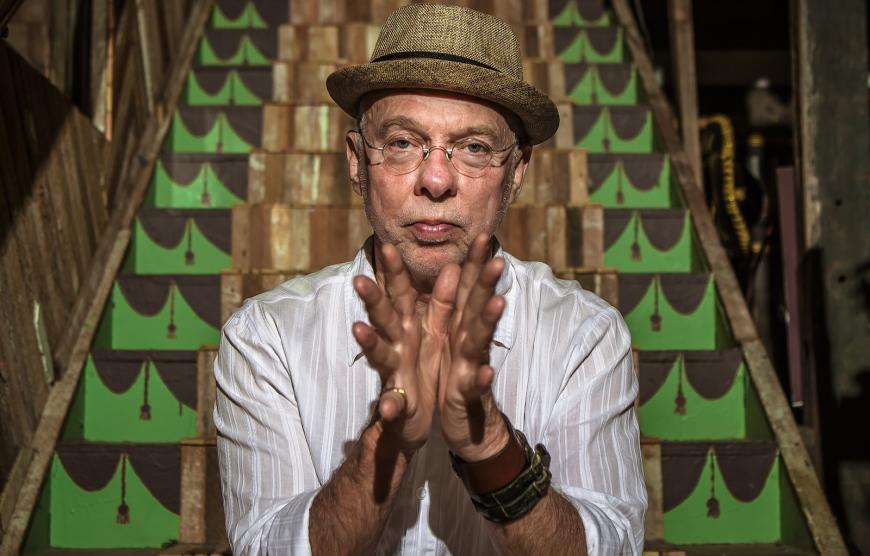
What are the dynamics of your role and experience working with your spouse under the umbrella of the trio collectively known as the Evie Ladin Band?
I’m a sideman in this context. It’s taken awhile to figure it out because Evie and I are married. What is comfortable is to help serve her music, convey it the best I can, to be mainly the bass player and also sing harmonies. We’ve been together for 20 years and in the first few years our careers and projects were very separate. Then we found ways our musical lives could cross over. It wasn’t obvious, but we started finding more ways, worked a lot together for another 10 years. I was helping her realize her music and she was helping me realize my music. We found a few years ago that we’d crossed over so much we needed more space. We were working together all the time. We’ve pulled back for a while, touring separately and artistically separated a little more in our careers. Artistically, I’m going back to more drumming, which doesn’t work in the context of her band. It’s great that we’ve evolved to new levels that keep growing into new things.
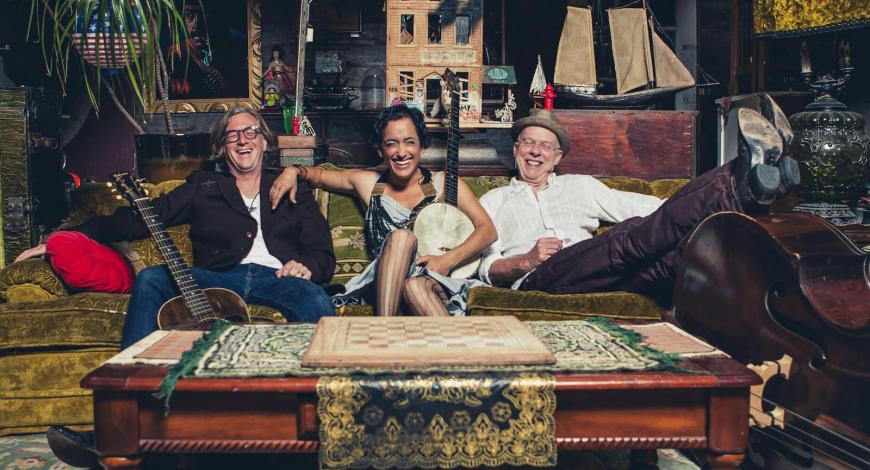
Speaking not so much about the power balance but about Evie as a banjo player and lyricist and mover: What words would you use to describe her?
Powerhouse. Driving. Lyrical. Wordsmith. Traditional/contemporary. Demanding. Prolific. Creator of live projects, videos, films. Heels down. Funky shuffle. Skilled conveyor of experience with lyrics. Tapped into humanity. Expresses the beauty of life.
What’s next? What kinds of projects have you not ever done or want to do more often or have done and never plan to revisit?
I’m feeling my age. I’m going to be 70 next month. There are things about administration that I’m over: the laser approach and concentration on things and details I used to care about, I don’t have that any longer. That’s affecting the kinds of projects I’m going to be doing. I’m enjoying the act of doing body music, of playing and making music with other people. That part has never gone away. The things you do to keep a band together? I have less interest in them.
I’m also a gardener and I farm in my backyard. I grow — in a tiny Oakland city lot — avocados, figs, blueberries, greens, garlic, apples, I have bees, pineapples, guavas. I’m also building a tiny house and thinking about alternative building materials, our relationship to spaces. I’ve got a lot of energy and interests. For these next 10 years, hopefully my health will hold and I’ll be able to enjoy exploring these things.


